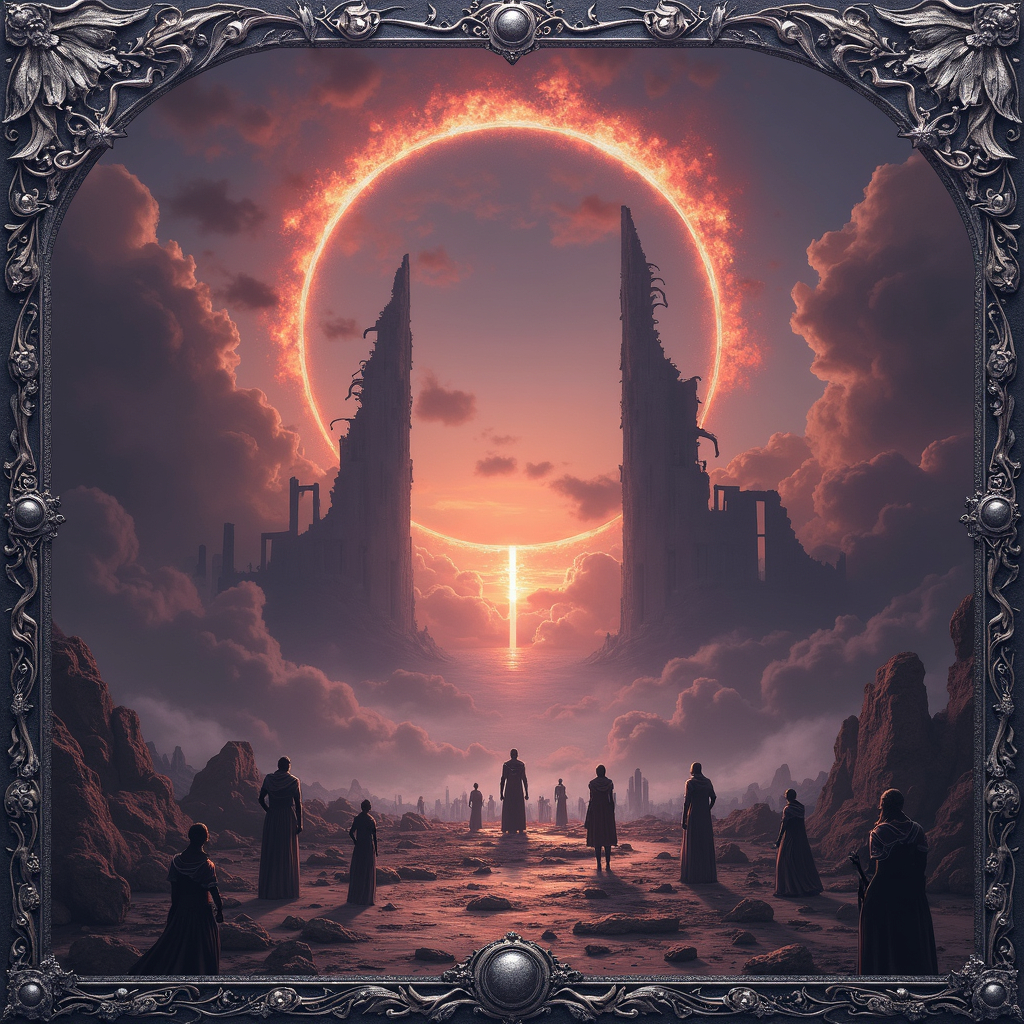
In the wake of the Betrayal at the Celestial Forge, when the Mother-Goddess Uzume was torn asunder, the multiverse
quaked in mourning. But though her body was broken and her soul cast wide, her firstborn children endured. The
Annarr, forged from her divine marrow, rose from the ruin of her death like fire from smoldering coals — changed,
but unbroken. These were beings of immense power and ancient will, shaped not merely to serve but to shepherd. To
some, they are saviors. To others, tyrants cloaked in celestial fire.
The Annarr are few, their names whispered in fear and reverence: Frur the Fertile, Skald, cold of heart, Aeter the Lightbringer, and Njord the Stormlord.
Each carries a fragment of Uzume’s original purpose, though time and sorrow have twisted many from what they once were.
And yet, even the Annarr are not safe from the rot that crept in after Uzume’s fall. Betrayal breeds betrayal, and
from within their own ranks stir whispers of war and blasphemy. For not all of them mourn their mother. Not all
believe the multiverse needs her gift.
Thus do the Annarr and their companions, the Annarr-kin, walk the twilight edge between light and ruin — torchbearers of a dying divinity.
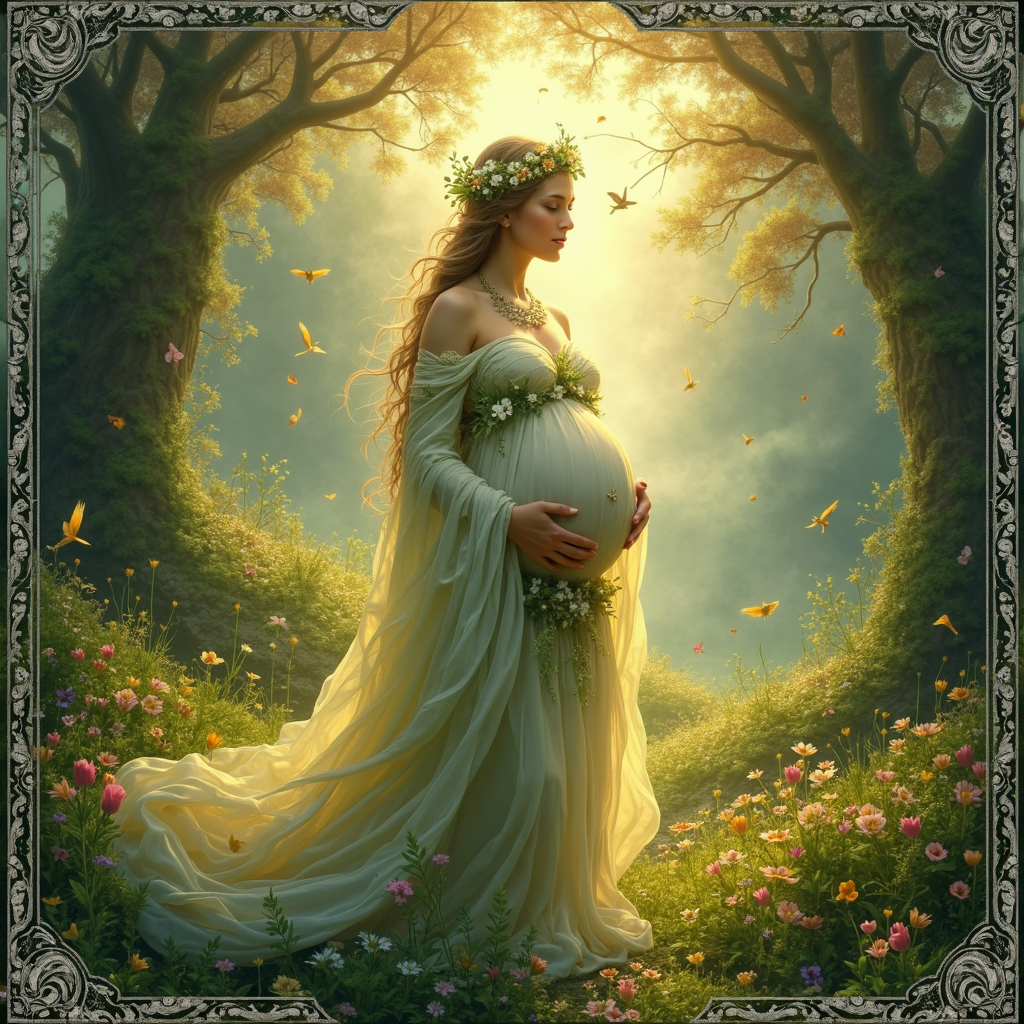
Frur
Often referred to as the true successor to Uzume, Frur is
envisioned as the gentle yet potent Goddess of Fertility, caretaker of fields, flocks, and families. Enshrouded in
robes woven from fresh blossoms and new spring shoots, she radiates a serene, nurturing presence — a living
embodiment of growth and renewal.
Symbols
- Crescent of Seeds: A diadem crafted from grain and poppy seeds, representing both nourishment and the potential
of new life.
- Twining Ivy Staff: Symbolic of life's interconnectedness, this staff sprouts new buds whenever fertility blooms
nearby.
- Aurora Cloak: A shimmering mantle reflecting Skazka's cycles — vibrant greens in spring, golden in harvest, muted
in winter — mirroring seasonal growth.
Domains
- Cultivation & Harvest: Farmers invoke Frur before tilling, believing she bestows fertile soil and timely rains.
In story, she whispers to the earth, coaxing sprouts from fields, or burbles in brooks to water parched lands.
- Childbirth & Family: Midwives whisper prayers to Frur during labor. She stands sentry at newborn’s cradle,
offering blessings of health and bounty. In folklore, a whispered chant—“Frur guide us, Frur protect” — is said to
ease childbirth and inspire maternal strength.
- Renewal & Rebirth: Legend holds that Frur visits hibernating animals, stirring them awake when spring is near.
In the wild, flowers ahead of schedule are believed to signal her passing.
Rites
- The Springward Dance: Every spring, maidens and farmers process to an ancient grove at dawn. They dance in
circles, tossing flower-imbued seed-pouches into the earth — a ritual believed to awaken Frur’s blessing upon every
ploughed furrow.
- The Night of Blooming: Legends say that once a year on the longest night, Frur wanders through sleeping
villages, leaving single flowers — daisies, poppies, violets — on doorsteps. Houses where a bloom appears are foretold
a year of prosperity or new life.
- The Coven of Green Shoots: In remote rural places, midwives and herbalists gather in Frur’s name, brewing
teas made from herbs and spices to support healthy pregnancies. Their sacred circle is rung with ivy and wheat, echoing
Frur’s staff — and believed to channel her spirit during delivery.
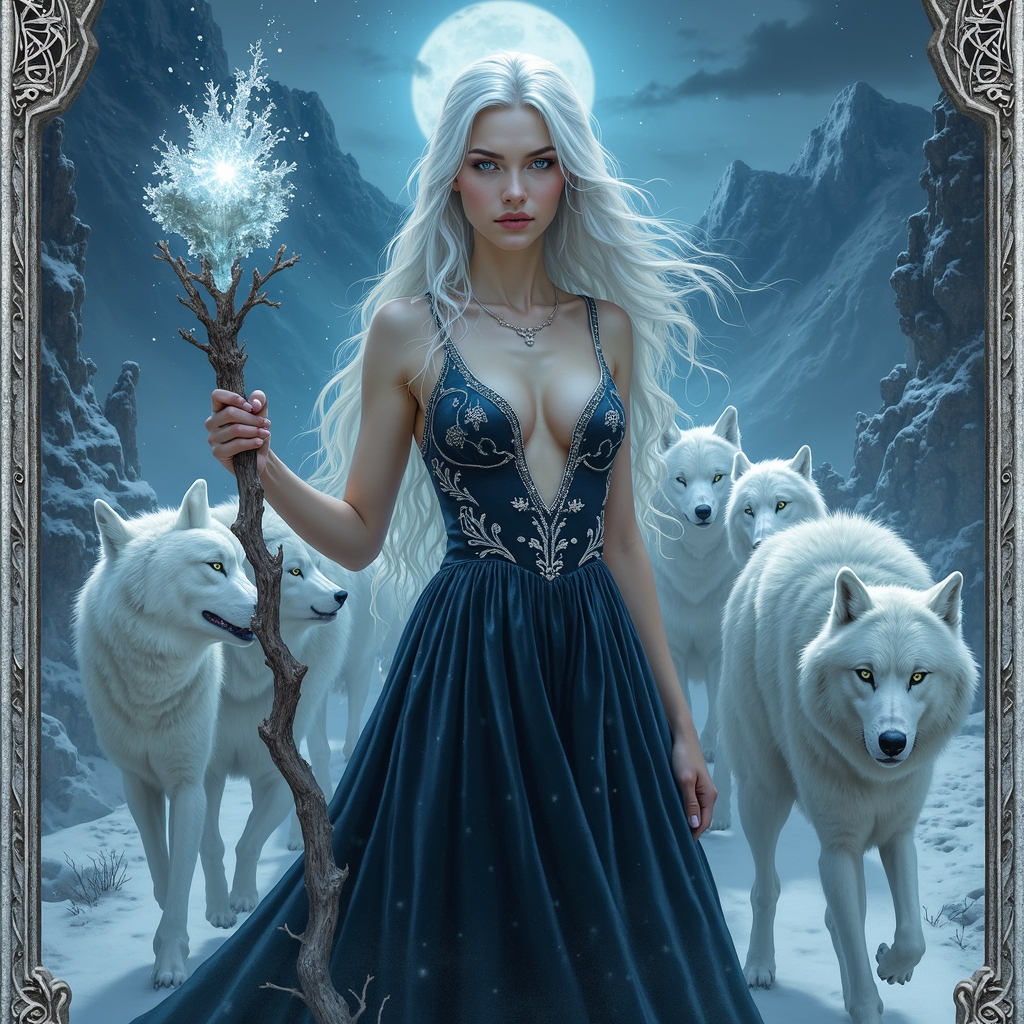
Skald
Skald emerges as the austere Goddess of Winter and steadfast Protector of Wolves. Draped in fur-trimmed pelts, her
presence is as crisp and biting as the first frost — distant yet undeniable, her power carved from the unforgiving
cold. She is neither benevolent nor malevolent, but a primordial force championing survival of the fittest and
believing in the autonomy of mortals to determine their destinies.
Symbols
- Moonlit Wolfsbane Crown: A circlet of silvery wolf-tooth and moonflower, signifying her bond with lupine
creatures and the moonlit chill of winter nights.
- Glacial Spear: A spear of living ice that never melts, used to mark her domain over frozen lands and to
challenge the worthy.
- Hunting Cloak: Hidden within its fur-lined seams, she carries a wolf pelt that she wraps around weakened
spirits — offering either resurrection or reassurance that only the strong prevail.
Domains
- Winter’s Challenge: Skald governs the biting cold, fierce snowstorms, and long polar nights. Hunters and herders
whisper appeals to her for guidance through blizzards — but they know she offers no mercy, only truth.
- Guardian of the Pack: Wolves roam freely under her watch, their howls the echo of her voice. She teaches that
unity and strength breed survival — yet only the strongest wolves lead the pack, unworthy ones cast out.
- Mortal Autonomy: Skald holds a hands-off philosophy - races must forge their own paths. She intervenes only when
natural order demands it — be it famine, animal migrations, or beasts turned rabid. In her view, self-reliance is
the highest virtue.
Rites
- The Hunt of the White Night: On the coldest night before the winter solstice, hunters seek her favor. They enter
thawing forests at midnight, tracking a lone white wolf said to be an avatar of Skald. To slay it would invite her
wrath; to let it pass honors the goddess — and offers glimpses of their own strength.
- The Frost-Bound Oath: When new wolf pups are born under deep snow, packs leave a single white feather on their
den's threshold — a pact recognizing Skald’s guidance and promising to follow the strongest among them without
question.
- Feast of the Frozen Thaw: At the cusp of spring, tribes gather meat from their hunting seasons — smoked and
preserved. They form a circle by the great fire, sharing stories of winter’s trials. One 'lone wolf' prowls the
edges serving as Skald’s presence. Survivors return to hearths with renewed respect for both natural order and
their own resilience.
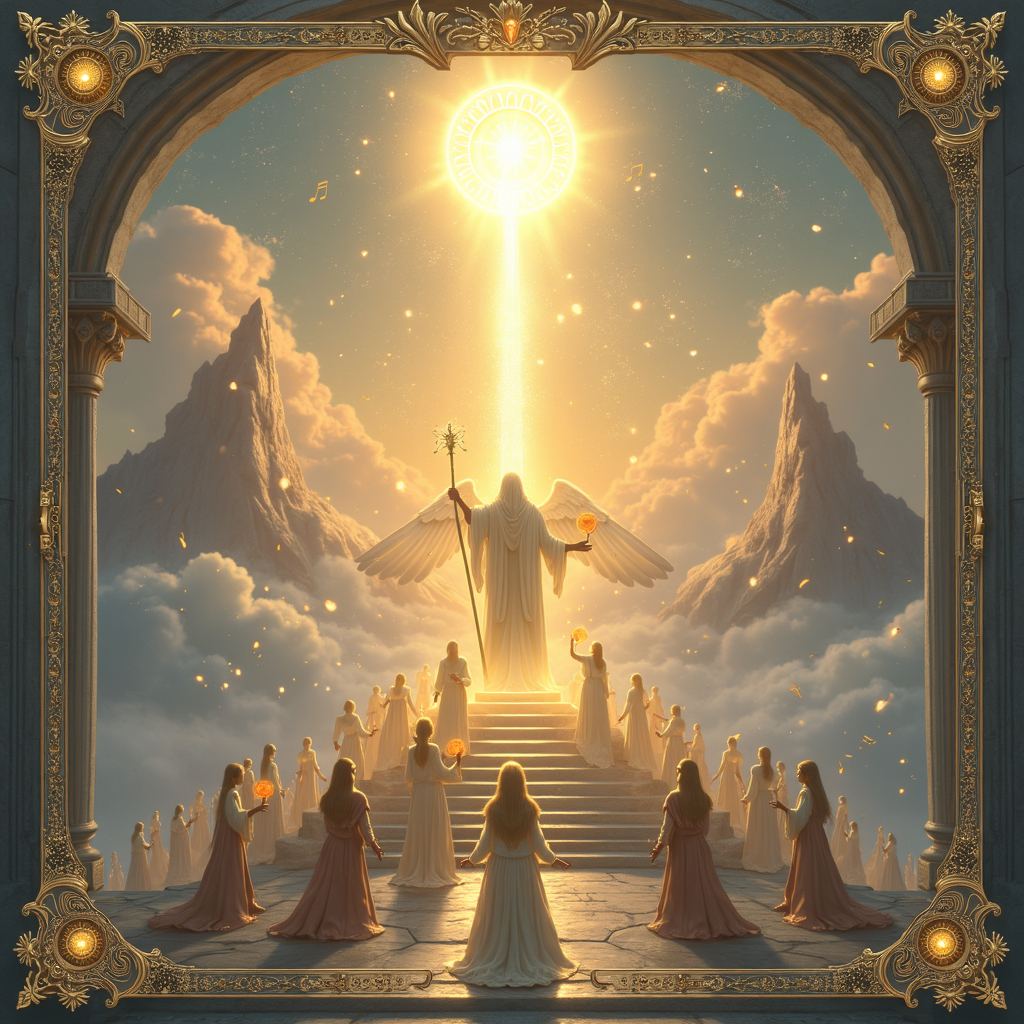
Aeter
In the mythic pantheon of Skazka, Aeter, the radiant God of Light, reigns as a beacon against encroaching
darkness — both literal and spiritual. His brilliance brings clarity, hope, and renewal, yet he is neither naive nor
blind to temptation: true light requires responsibility. As the keeper of the celestial forge, Aeter is revered by
scholars, healers, and those who seek to banish shadow from the soul.
Symbols
- Crown of Dazzling Rays: Forged from pure light, it glimmers like the sun at zenith — an emblem of his boundless
presence and wisdom.
- Everlight Orb: A small globe of concentrated sunlight that never dims — its warmth is healing, its glow reveals
truth, and it can shatter unholy darkness.
- Radiant Scepter: Topped with a living flame that burns with the warmth of dawn, this staff channels his
influence whenever light is needed.
Domains
- Illumination & Truth: Aeter is the arbiter of clarity, exposing lies and unveiling hidden things. Scholars
invoke him in pursuit of knowledge; judges in service of justice.
- Hope & Renewal: Especially during total darkness — night, winter, loss of faith — his presence reminds the
pantheon’s followers that morning always returns.
- Civilization & Artistic Flame: Poets, architects, musicians, and artisans seek inspiration from his glow.
Creativity flourishes under his favor, pushing civilization ever forward.
Rites
- Dawn’s Renewal: At the break of dawn, Sun Elf communities gather in temple courtyards to kindle communal
Everlight lamps. Each person brings a reflective plate that captures the morning sun before passing it to their
neighbor — a symbol that light, once shared, grows brighter.
- The Everlight Trials: Young Sun Elves undergo a trial under Aeter’s observance. They must craft or shape
something that reflects light —be it glasswork, art, song, or architecture. Success demonstrates mastery of both
craft and purpose; failure reminds them that light untended fades.
- Feast of the Turning: On the summer solstice, temples open every window and let shouts of “Aeter, guide our
path!” ring out at sunrise. Pilgrims carry candles that burn black smoke which turns godlen in the dawn light.
Lore: The Sunlight Gift & the Birth of the Sun Elves
Long ago, when dark elven exiles — driven from the Underdark by their own misdeeds — fled upward to the realm
of mortals, they were twisted by shadow and despair. Aeter pitying them, reached down and cast a fragment of pure
sunlight into their midst: the Everlight.
The infusion of Aeter’s gift altered their essence. Their once-dark skins glowed with a gentle
luminescence, their eyes reflecting dawn’s first light. These exiles became the first Sun Elves, noble and fair,
dedicated to justice and to spreading light wherever darkness threatens.
Over generations, Sun Elves built grand solar temples, inscribed with stories of Everlight and Aeter’s benevolence.
Each dawn, temple priests rekindle their altars with purified sunlight captured at sunrise, ensuring the god’s flame
never fades.
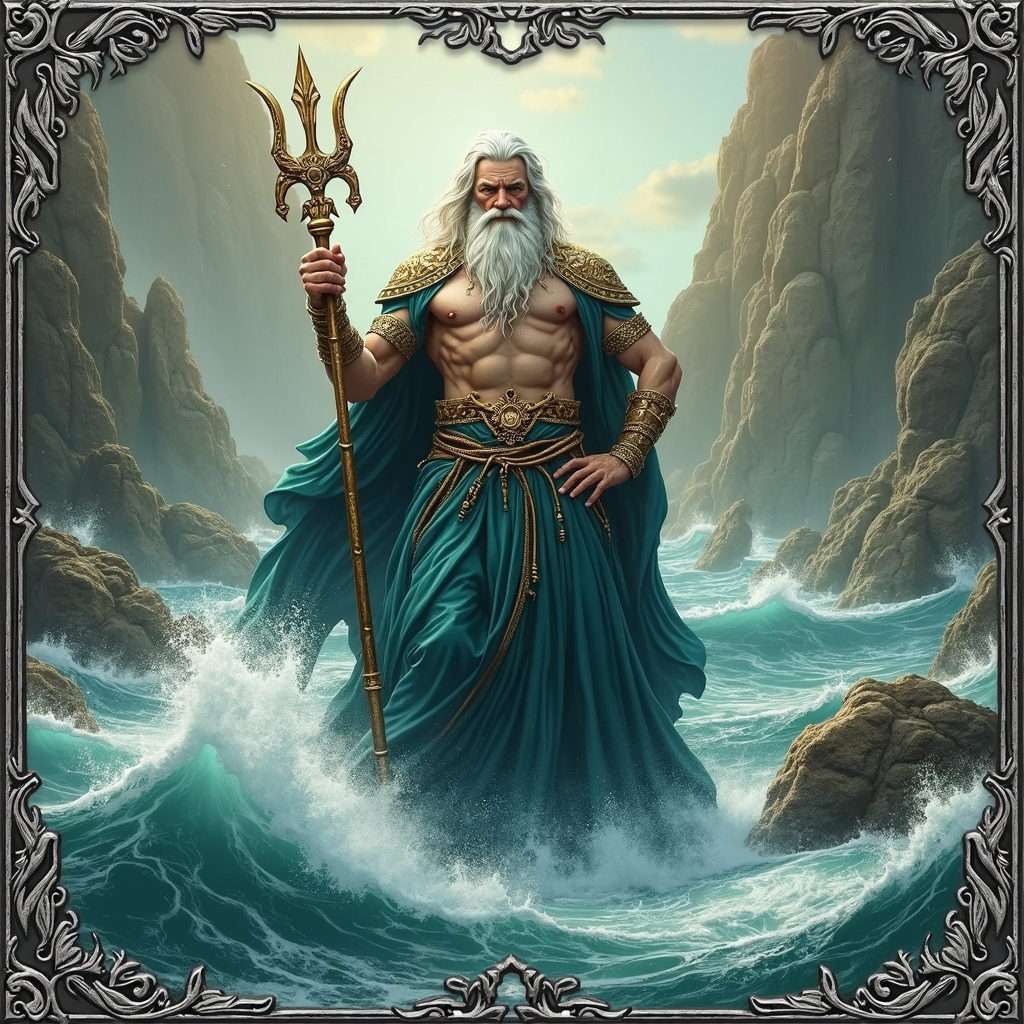
Njord
In the pantheon of Skazka, Njord, the God of Storms and Anger, reigns as a roaring tempest. He is the
embodiment of raw power and unbound fury — most akin to Kaos among the Annarr. Njord is neither savior nor destroyer by
intent, but rather a force that challenges mortals to seize strength, seize power, or be swept away.
Symbols
- Cracked Helm of Thunder: Forged from storm clouds and lightning, this helm echoes with thunder whenever Njord rages.
-
Stormreaver Trident: A jagged weapon that harnesses wind, sea, and electric fury — calling hurricanes or calming
catastrophic deluges at his will.
-
Stormcloak of Roaring Gales: A cloak woven from gale-force winds and vaporous clouds. It whips around him in battle,
tearing at foes and stirring courage in allies.
Domains
-
Storm & Fury: Njord commands lightning, roaring winds, and crushing waves. Sailors dread and respect his presence: appease him, and
he grants safe passage; defy him, and ships vanish in whirlpools.
-
Anger & Resolve: In his rage, Njord symbolizes both the destructive and galvanizing power of anger. He punishes those weak of
conviction and empowers those who channel rage into action.
Power & Meritocracy: He embodies the survival-of-the-fittest ethos: power carved through struggle and borne by those who endure. He brooks
no excuses or charity; only the strong earn his favor.
Rites
-
The Siege of Stormkeep: When Orcs besieged the coastal fortress of Stormkeep, Njord unleashed a week-long tempest. Waves battered the
walls, lightning shattered siege towers, and only those defenders proven in battle earned spared lives. The story ends
with the surviving knights swearing oaths under thunder to never yield.
-
The Trial of the Roaring Shore: A rite of passage for warriors and sailors. They stand on the high cliffs as storms surge around them. Those who hold
steady and return victorious are said to have Njord’s grit; those who falter are cast out — literally washed away by the
returning tide. Those that fail are said to rise as 'The Drowned' - an undead creature bound to some Njord for eternity.
-
Festival of the Wrathwind: On the equinoxes, massive bonfires are lit along the coasts. Those that build these fires test their skill at keeping the fires
alight during the storm. A blessing is said to be received - the Storm Kiss - by any who keep their watchfires going until dawn.




